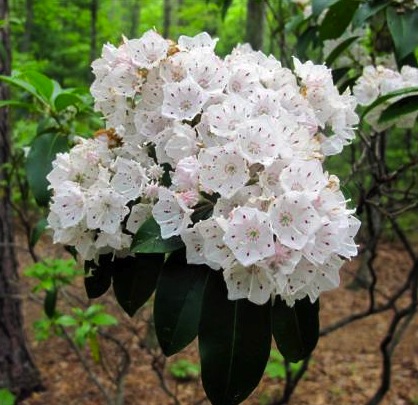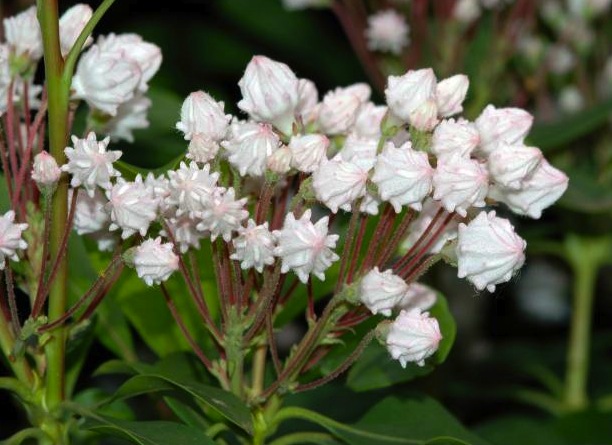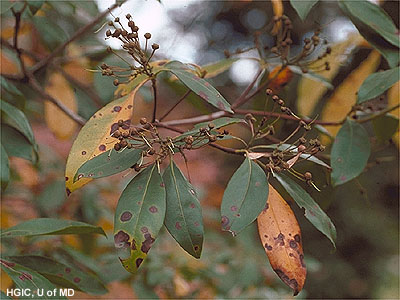Mountain Laurel Beauty and Wonder
by Barbara Shepard, Fairfax Master Gardener
Ever walked through woodlands in late spring and spied a pretty flowering shrub that looked a bit familiar but you were unable to identify? Possibly it was mountain laurel, a plant with some characteristics similar to the rhododendron. They are both in the Heath (Ericaceae) family, whose other members include azalea, blueberry, huckleberry and cranberry.
 As a child, I used to roam through the fields and hillsides of the Allegheny Mountain region of Pennsylvania, and each spring mountain laurel would capture my attention. I admired its large clusters of umbrella-shaped, pinkish-white flowers drooping from branches with green glossy leaves with a yellow mid-vein. In some places, whole hillsides would be covered with mountain laurel; in other areas, it would rim the edges of a wood or a meadow, or grow along the gritty banks of a stream. Indigenous to the entire Appalachian Mountain region, it can grow to be a large shrub or a small tree, sometimes significantly larger than 12 feet high (4 m) and wide in the perfect habitat.
As a child, I used to roam through the fields and hillsides of the Allegheny Mountain region of Pennsylvania, and each spring mountain laurel would capture my attention. I admired its large clusters of umbrella-shaped, pinkish-white flowers drooping from branches with green glossy leaves with a yellow mid-vein. In some places, whole hillsides would be covered with mountain laurel; in other areas, it would rim the edges of a wood or a meadow, or grow along the gritty banks of a stream. Indigenous to the entire Appalachian Mountain region, it can grow to be a large shrub or a small tree, sometimes significantly larger than 12 feet high (4 m) and wide in the perfect habitat.
The plant has a rounded shape with irregular branching, leaves 2 to 5 inches (5 to 12 cm) long and up to 1.5 inches (4 cm) wide; its trunk can be gnarled and twisted.
Designated as the state flower of Pennsylvania in 1933, mountain laurel blooms there in late May and June. It is also the Connecticut state flower, having claimed that distinction in 1907. In Virginia, you can find mountain laurel in all but a few counties in the lower Piedmont. It blooms from May into June along trails, roadsides, at the edges of fields and pastures, and along power lines and railroad rights-of-way. You can see it growing in great masses along the Blue Ridge and westward.
What’s so great about it?
For me, it has always been the shape of the individual flowers and how they hang from the branches in 4 to 6-inch (10 to 15 cm) clusters: one bunch is a small bouquet all in itself. The individual flowers in the cluster have been best described as a five-sided, upturned umbrella. The flowers are waxy, usually with pink dots and a wavy pink line in the center. In some cultivars, the individual flowers can be as large as 1-inch wide (2 cm).

Mountain laurel buds
However, before the flowers, there are also the attractive buds — conical, fluted, and a deeper color than the open flowers — and these are just as eye-catching as the flowers. And when you get a mix of the buds and flowers at the same time, you get a double treat! Bud colors include light to dark pink, and red; flower colors include white, light and dark pink, and bi-color.
Not to be overlooked, the leaves serve as a nice backdrop to showcase the colorful buds and flowers. They can be wide, long, and glossy deep green to narrow, willow-like shapes in a lighter green shade. There is usually a yellow mid-vein, and some have yellow around the edges as well. On a recent trip to the local garden center, I found a cultivar that had long yew-like stems and leaves.
Mountain laurel does produce non-showy brown fruits that last into winter. The fruit is described as a five-celled capsule that, when open, has the look of a sectioned orange.
A bit of history
A native plant indigenous to the Appalachian Mountain region, mountain laurel (Kalmia latifolia) was first recorded in America in 1624. Peter Kalm, a Finnish botanist, was the first to study these plants in eastern North America from 1747-1751, and the genus Kalmia was named for him. Latifolia means “wide leaf”, a characteristic that differentiates Kalmia latifolia from five other species of Kalmia natives. Kalm also discovered the plant’s toxic effects after noticing that sheep grazing on it died. The plant received its common name of “lambkill” as a result. Another common name, “spoonwood,” came about from Native Americans’ use of the wood to make spoons.

‘Sarah’
All parts of the plant are poisonous to animals and may be fatal if ingested. Its two toxins can be fatal to hoofed browsers, depending on the amount eaten, with sheep among the most susceptible. Honey made from mountain laurel pollen is also believed to be poisonous, and can cause severe reactions if mountain laurel (or any of the heath family plants) represents the majority of the pollen used by the bees.
The difficulty of propagation kept this wonderful native shrub out of our gardens for quite a while. Richard Jaynes, a geneticist and horticulturist at the University of Connecticut with a passion for Kalmia latifolia, was one of the earliest hybridizers of mountain laurel. As a plant breeder he has developed and introduced dozens of new cultivars. Thanks to Jaynes’ work and that of breeding programs at universities and nurseries over the past decades, there are now more than 80 cultivars from which to choose. The choices range from differences in bud color and size, bloom color and size, leaf color, size and shape, and shrub size and growth habit.
Use in the landscape
A broadleaf evergreen, cold hardy in zones 4-9 and heat tolerant in zones 9-10, mountain laurel can be used in either a formal or natural setting. Typically a medium-sized shrub in the garden landscape, it is slow growing. Mountain laurel is a good shrub for woodland settings, or massed and grouped for use as a hedge, screen or border and even as a foundation or specimen plant. Light pruning will keep it compact for more formal gardens, or gardeners can choose dwarf varieties no larger than 3 feet high (1 m) and wide. A shade exposure from the hot afternoon sun is recommended, as well as protection from winter winds. Although a bit more drought tolerant than rhododendron, it is not tolerant of wet sites. Its growth is denser in low, wet areas, and sparser in dry areas. The plant’s density is also affected by the amount of light it receives.
In the Southeast, mountain laurel provides some cover for wildlife, nesting sites for birds, pollen and nectar, and food for caterpillars. In the Mid-Atlantic, the shrub provides pollen and nectar.
Make it thrive
The two most important points for growing a healthy mountain laurel in your garden are these: first and foremost, plant it in a very well-drained, loose acidic soil (pH range of 4.5 to 5.5); soils with high amounts of organic matter are ideal; second, give it a part-shade exposure in the afternoon and protection from winter wind.
Best growth and appearance occurs in part shade — three to four hours of morning sun and early- to mid-afternoon shade, although they will tolerate full sun to full shade; plants will have some drought tolerance once established. With the absolute requirement for well-drained soil, amending the soil in your planting hole with organic matter will greatly increase your chances for a healthy plant. The Virginia Native Plant Society suggests pine bark as a good soil amendment, and also as a mulch to keep the shallow roots slightly moist and cool. Another recommendation is to dig a hole only half as deep as the soil ball and then place the plant into the hole and cover the protruding root ball with a highly organic soil. If you have clay soil (don’t we all?), you might consider a raised bed.
Do not fertilize your newly planted laurel — wait one year. Use an acid-based, soluble fertilizer, and divide into three feedings: one-third in early spring before flowering, one-third immediately after flowering, and one third a month later. Don’t feed after late July; you do not want to stimulate new growth that won’t have time to harden off before cold weather. Removing spent flowers will prevent seed formation and result in more flower buds for next spring’s bloom. Any necessary pruning should be done immediately after flowering. Flower buds are formed by September. To keep plants looking tidy, you can pinch back a few of the new growing tips each year just an inch or two while deadheading.
Problems and pests

Fungal leaf spot
Mountain laurel is generally free of problems from diseases or pests, but still needs a watchful eye in that respect. It is susceptible to leaf spot and blight, also to borers, scale, white fly and lace bug. Leaf spot can be troublesome in moist heavy shade, but in most cases this fungal disease will not threaten the health of the shrub. Provide good air circulation, rake and remove infected leaves in the fall, prune or remove infected/dead twigs during the winter or dry summer months. Lace bug is more of a problem when plants are stressed, especially those growing on sunny sites. Also, plants situated in hot sunny sites are subject to foliar burn. In general, a plant that is not stressed from too much sun or poorly drained soil is in a better position to survive these problems.
Some cultivars are bred for resistance to leaf spot (some examples: Bay State, Bridesmaid, Carol, Carousel, Heart’s Desire, Nathan Hale, Olympic Fire, and Pinwheel). There are, of course, fungicides to apply if the need arises.
Common cultivars available locally
| Bullseye | purple band of pigmentation inside. Does not set flower buds when young, has a vigorous, upright growth habit; emerging foliage is reddish |
| Carol | buds dark-pink, flowers light pink to nearly white; dense growth, compact and low; shiny green foliage with wavy margins; leaf spot resistant |
| Carousel | reddish buds, flowers have an intricate pattern of bright purplish-cinnamon pigmentation on the inside, edges marked with white. A vigorous grower with dark green, glossy narrow foliage with yellow edges; leaf spot resistant |
| Elf | The first miniature or semi-dwarf K. latifolia introduced. Smaller narrow leaves, slower growth and leaves closely spaced along the stem. White and nearly full-sized white flowers; pink buds |
| Minuet | light pink buds, white flower with wide, almost cherry-red band inside; very glossy, dark green narrow foliage slightly cupped; a miniature, dense growing, fatter stems than most; |
| Nipmuck | red buds, flowers open pink; narrow leaved foliage |
| Olympic Fire | an older, very popular form with red-pink buds, light pink blooms; wavy, glossy, narrow foliage with yellow and red veins; highly resistant to leaf spot |
| Ostbo Red | the first red-budded selection to be named; whitish-pink flowers darker pink at edges, growing darker as they age; leaves wide and cupped, somewhat smaller than the species; fairly dense habit |
| Peppermint | white flowers with 10 red “spokes” radiating from the center; wide foliage |
| Raspberry Glow | burgundy-red flower buds, very deep pink flower; proven to be very tolerant of adverse landscape situations in University of Connecticut tests |
| Tiddywinks | semi-dwarf, low compact, mounded habit. Buds strong pink, soft pink blooms |
… updated 2024
- References
- Mountain-Laurel, Kalmia latifolia, Virginia Cooperative Extension Publication 3010-1494
- Mountain Laurel, Virginia Tech Dendrology
- Selecting Plants for Virginia Landscapes: Showy Flowering Shrubs, Alex X. Niemiera, Virginia Cooperative Extension Publication HORT-84P